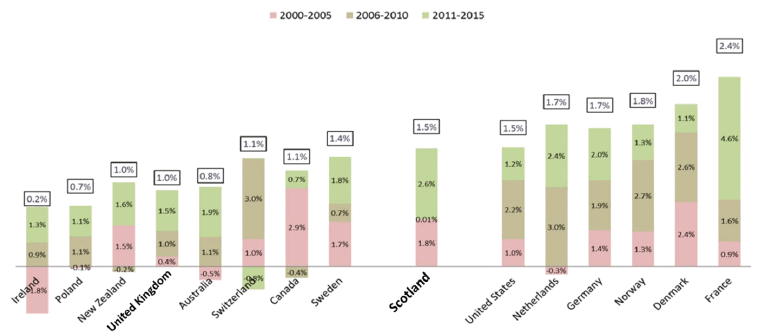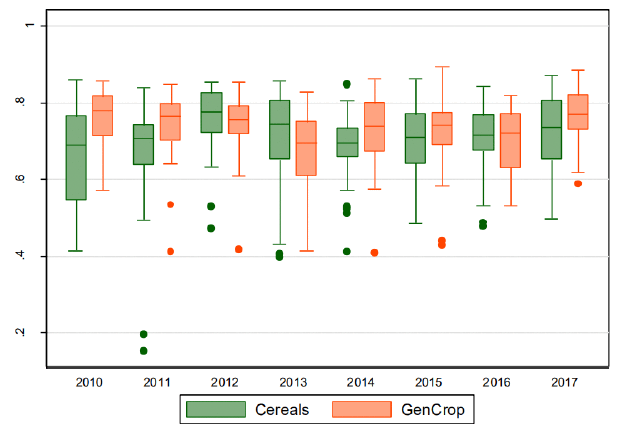Arable Farmer-led Group: climate change evidence
A summary of existing evidence around the arable sector, including greenhouse gas emissions produced by the Rural and Environment Science and Analytical Services (RESAS) division.
3 Performance and Productivity
3.1 Key Metrics for Performance and Productivity
3.1.1 Total Factor Productivity
Productivity refers to the efficiency of production. One method of quantifying productivity commonly used is Total Factor Productivity (TFP). This looks at an industry's overall efficiency in converting all of its inputs into all of its outputs, and is usually presented in terms of TFP growth over time.
Productivity is a key measure of sustainable growth, and growth in productivity is usually assumed to be related to the increase and adoption of new technology. In the case of agriculture, low productivity means more inputs per unit of output, which may lead to higher pollution, lower wages and lower farm incomes.
SRUC's Boosting Productivity Growth in Scottish Agriculture report assesses productivity of agriculture in Scotland and elsewhere. Since 2000, agricultural productivity has been growing, with average annual growth of 1.5%. Scottish agricultural productivity appears to have had stronger growth than UK agricultural productivity overall. However, it is important to note that this is from a fairly low base.

Source: Boosting Productivity Growth in Scottish Agriculture
The chart above shows international estimates of agricultural productivity growth, with variation over time. Scotland appears to sit around the middle of international rankings of agricultural productivity growth. It is important to note that the Scottish Government uses data from the census to calculate agricultural TFP internally, whereas TFP growth for the other countries is based on data published by the United States Department of Agriculture (USDA). Therefore, this comparison should be viewed with some caution.
In the case of agriculture, productivity can be heavily impacted by factors such as land quality, weather conditions and outbreaks of crop and livestock diseases. There are challenges to supporting agricultural productivity in Scotland, particularly around land and weather disadvantages, and lack of adoption of new and existing technologies.
There is wide variation in performance between farm types and within farms types in Scotland, as shown below. There are clear differences in TFP between farm type and between time periods, with cereals showing the strongest TFP growth in recent years.
| Years | Cereals | General Cropping | LFA Cattle and Sheep | LFA Sheep | LFA Cattle | Dairy |
|---|---|---|---|---|---|---|
| 2000-05 | -0.2% | -0.7% | -0.2% | +0.4% | +0.1% | -0.1% |
| 2006-10 | -1.4% | +1.0% | +0.9% | +0.6% | +0.1% | +1.3% |
| 2011-17 | +1.2% | +0.7% | -0.3% | -0.1% | -0.8% | -2.1% |
Source: SRUC, Boosting Productivity Growth in Scottish Agriculture, April 2020
Performance within the Cereals and General Cropping farm types also fluctuates over the years, with Cereals showing the highest volatility and range in economic efficiency (a farm-level measure of productivity[37]). This is potentially due to their specialisation within specific crops and vulnerability to global market prices and weather variances.

Adapted from SRUC, Boosting Productivity Growth in Scottish Agriculture, April 2020, p. 5.
3.2 Options for Improving Performance
SRUC's Boosting Productivity Growth in Scottish Agriculture report provides a high level summary of a long list of measures which would potentially increase productivity in Scottish farming broadly covering approaches to information sharing, financial schemes and management changes. Information sharing covers, for example, knowledge exchange, education and implementation. Financial schemes covers positive and negative effects of support and grant schemes. Further details on these can be found in Annex E. It should be noted that there are limits and caveats to both uptake and effectiveness of these measures and the report was not specifically targeted at the arable sector.
The SRUC report highlights that in Scotland there is generally a low uptake of current, mainstream technologies and techniques. One of the main technologies to have potential to affect agricultural production in developed countries is the concept of SMART farming and interconnectivity of machinery with data gathering and analysis for decision making. Precision Agricultural Technologies (PATs) represent a suite of technologies and approaches that reduce variability at the field or herd level. This provides a holistic system approach to managing spatial and temporal variability to increase profitability, optimize yield and quality, and reduce costs and environmental impact.
3.2.1 Current Uptake
SRUC highlighted, in the same report, that the bulk of adoption among the surveyed Scottish cereal and potato producers is on machine guidance and variable rate systems. Both have been found, in multiple farm studies, to reduce fuel use and management time if used optimally. However, issues have been identified around the appropriate level of training of farmers to operate PATs needed to raise returns and productivity to noticeable levels. Further options, such as nutrient management, soil nutrient mapping, improved soil management, changing cereal yields, and varietal uptake, have also been shown to improve yields. These are covered in Annex E.
The Scottish Survey of Farm Structure and Methods (2016) collected information on, for example, tillage methods, soil conservation, manure application, manure storage, and irrigation. While not all of the below measures directly increase yield, they may improve efficiency, decrease GHG emissions, and/or improve biodiversity, which will result in indirect increases in yields. Many of the measures below, including tillage methods, nutrient management and slurry methods are also covered across many of the GHG mitigation measures listed in Section 2.2 confirming that many of the GHG measures could also result in financial gains.
3.2.1.1 Tillage methods
More intensive tillage systems, such as conventional ploughing, leave low levels of crop residue cover, whereas reduced tillage methods leave about 30% or more residue cover. These residues reduce the amount of soil erosion, soil compaction and fuel consumption. Reduced tillage or no-till systems will also increase levels of soil organic carbon, and may result in lower direct carbon emissions from the soil (see e.g. Table 7 on page 20).
In 2015/16, conventional inversion tillage was used on the majority of land (90%), with reduced, conservation tillage on 6% of land.
3.2.1.2 Winter soil cover
Maintaining soil cover over the winter is a practice aimed at reducing soil erosion and the loss of particulate pollutants (e.g. plant protection products and faecal microbes), in addition to contributing to the amount of organic matter in the soil. The survey asked about coverage of land sown/cultivated over the preceding winter (i.e. winter 2015/16), including if the soil had been left bare.
In 2015/16, 42% of respondents said that they had sown or cultivated autumn or winter crops over the winter, while a further 42% said they had sown or cultivated plant residues or stubble. A small proportion (3%) said that they had sown or cultivated cover or immediate crop, while 13% had left their soil bare over winter.
3.2.1.3 Crop rotation
Crop rotation is the practice of alternating crops grown on a specific field each year in a planned pattern or sequence. The proportion of arable land not included in a holding's crop rotation is intended to give an indication of the degree to which monoculture is undertaken. The use of monoculture is also linked to environmental disadvantages and can have adverse effects on the productive capacity of the land. Crop rotation can also result in potential emission savings, as shown in Table 7.
In 2015/16, over half (54%) of holdings with arable land included all their land in general crop rotation, and a further 19% left out only 0-25% of their arable land.
3.2.1.4 Irrigation
Finding suitable sources of water for irrigation is a major problem in many countries in Europe, and is becoming more of an issue in Scotland in some eastern areas. Additionally, inefficient and unplanned use of irrigation can lead to over-wet soils which can affect yields and lead to leaching of nutrients. The use of monoculture is also linked to environmental disadvantages and can have adverse effects on the productive capacity of the land.
It was reported that a total of 94,000 hectares of land (2% of the crops and grass in the survey) could be irrigated using the equipment and the quantity of water normally available at the location.
Just under 2,000 holdings with crops (just under a fifth of all holdings with crops) had undertaken irrigation in the twelve months up to March 2016, over an area of 26,000 hectares (just under 5% of crop area).
3.2.1.5 Nutrient Management
In 2015/16, 17% of holdings with grassland had carried out a nutrient management plan on their grassland, and 42% of holdings had carried out a nutrient management plan on their other land. Nearly a third of holdings with grassland had carried out pH testing on their grassland, while 64% of holdings had carried out pH testing on their other land.
Of those with temporary grassland, 16% of holdings reported that some of it was sown with a 'low n variety mix', such as red clover. The area sown accounted for 21% of grassland on surveyed holdings.
Much like reduced tillage and crop rotation, improved soil management can also result in potential emission savings (again, shown in Table 7).
3.2.1.6 Manure and Slurry
Immediate incorporation of manure and slurry, following application onto fields, can reduce environmentally harmful ammonia emissions, and preserves nitrogen in the soil. A threshold of four hours from the time of application to manure and slurry being ploughed in, along with immediate injection of slurry, is used to define immediate incorporation. In 2015/16, 29% of holdings reported applying manure of slurry on their land. There were 12 million tonnes broadcast, of which 3% was ploughed in within four hours. There was a further 5 million tonnes applied with a bandspread, and a further 0.6 million 600,000 tonnes injected.
3.2.2 Farm Advisory Service
Initiatives like the Farm Advisory Service (FAS) can provide a link between national policy and individual farmers, which can then translate the goals of policy into concrete actions. The FAS 'One to Many' service was procured by Scottish Government as part of the broader Scottish Rural Development Programme (SRDP) 2014-2020, and sought to improve the business and environmental performance of Scottish Agriculture through the provision of advice. There is clear evidence that the FAS One to Many service delivered a wide-ranging programme, which appears to be well regarded by those who use it, as outlined in the recent Farm Advisory Service - One to Many: evaluation. However, this evaluation also demonstrated that FAS impacts are hard to measure. At present there is limited data about the extent of engagement with the programme, and limited monitoring of on-farm improvements resulting from that engagement. To ensure that the FAS can support policy delivery in the ways envisaged in this report, this gap will need to be addressed.
Contact
There is a problem
Thanks for your feedback